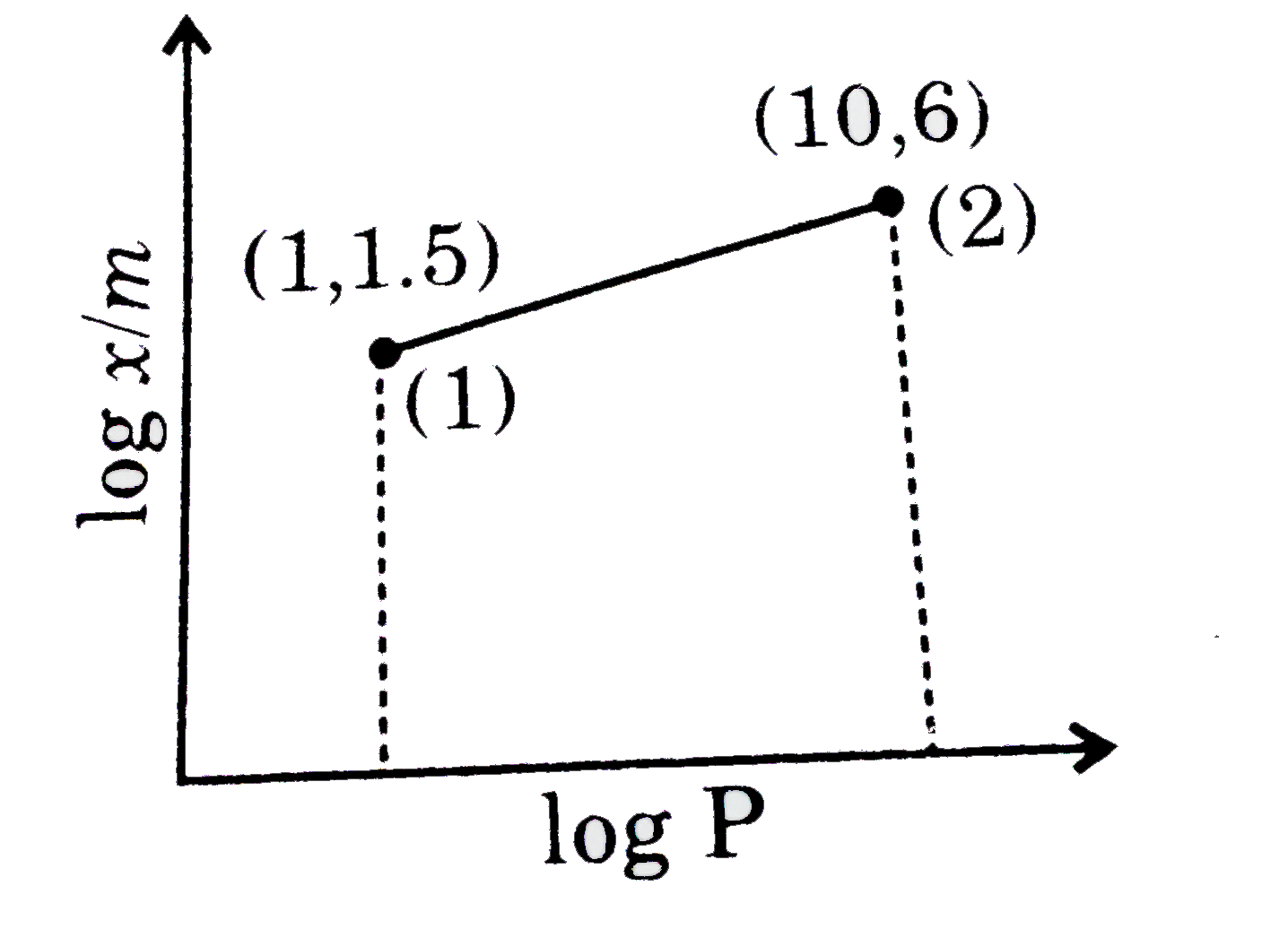During the adsorption of acetic acid vapours on the vapours on the surface of 1 g of animal charcoal, the following observations were recorded where x represents mass of acetic acied vapour adsorbed

Calculate the values of the constants n and k of Freundlich adsorption isiotherm.
According to Freundlich adsorption isotherm
xm=kP1norlogxm=logk+1nlogP
For abservation I: log0.7261=logk+1nlog0.56 ...(i)
For observation II: log0.4381=logk+1nlog0.210 ...(ii)
Subtracting eqn. (ii) From eqn. (i)
log0.7260.438=1nlog0.5760.210
or log(1.657)=1nlog(2.742)or0.219=1n(0.438)orn=0.4380.219=2
Substituting the values of observation I and n=2, in the equation
xm=kP1/n
0.7261=k(0.576)1/2=k(0.759)ork=0.7260.759=0.956≈1
Topper's Solved these Questions
- SURFACE CHEMISTRY BOOK - PRADEEPCHAPTER - SURFACE CHEMISTRY EXERCISE - CURIOSITY QUESTION
5 Videos
- SURFACE CHEMISTRY BOOK - PRADEEPCHAPTER - SURFACE CHEMISTRY EXERCISE - PROBLEM FOR PRACTICE
1 Videos
- SOME BASIC CONCEPTS OF CHEMISTRYBOOK - PRADEEPCHAPTER - SOME BASIC CONCEPTS OF CHEMISTRYEXERCISE - Competition (FOCUS) JEE (Main and Advanced)/Medical Entrance SPECIAL (VIII. Assertion-Reason Type Questions)(Type II)
13 Videos
Similar Questions
In the adsorption of acetic acid vapors by 1 g of charcoal, the following data was obtained :
x(cm3)0.7260.478p(cmofHg)0.5700.210
View SolutionThe following data were obtained for the adsorption of CO on 3 g of charcoal at 0∘C
Pressuer (mm) : 180 540
Volume of gas absorbed in cc raduced to STP : 16.5 38.1
Calculate the values of the constants k and n used in Freundlich equation.
View SolutionThe following data were obtained for the adsorptionof carbon monoxide gas on 3.0 g of charcoal at 0∘C and1 atm pressure.
Pressure (mmHg)200400Volume of gas adsorved,x18.631.4(reduced to STP)
Calculate the values of the constants k and n using Freundlich adsorption equation.
View SolutionFreundlich adsorption isotherm is obeyed by the adsorption where the adsorbate forms a multimolecular layer on the surface of adsorbent .In such cases, the degree of adsorption varies linearly with pressure but at high pressure, it becomes independent of pressure
The relation of Freundlich adsorption isotherm is :
xm=kP1/n
where ,K and n are constants.
Langmuir adsorption isotherm is obeyed by the adsorption where the adsorbate forms only a unimolecular adsorbed layer. The mathematical relation of Langmuir isotherm is :
xm=aP1+bP
In the mathematical relation of Freundlich adsorption isotherm ,the value of (1/n) is 0≤1n≤1.
(a) True (b) False
View SolutionFreundlich adsorption isotherm is obeyed by the adsorption where the adsorbate forms a multimolecular layer on the surface of adsorbent .In such cases, the degree of adsorption varies linearly with pressure but at high pressure, it becomes independent of pressure
The relation of Freundlich adsorption isotherm is :
xm=kP1/n
where ,K and n are constants.
Langmuir adsorption isotherm is obeyed by the adsorption where the adsorbate forms only a unimolecular adsorbed layer. The mathematical relation of Langmuir isotherm is :
xm=aP1+bP
Freundlich adsorption isotherm is valid for chemisorption .
(a) True (b) False
View SolutionFreundlich adsorption isotherm is obeyed by the adsorption where the adsorbate forms a multimolecular layer on the surface of adsorbent .In such cases, the degree of adsorption varies linearly with pressure but at high pressure, it becomes independent of pressure
The relation of Freundlich adsorption isotherm is :
xm=kP1/n
where ,K and n are constants.
Langmuir adsorption isotherm is obeyed by the adsorption where the adsorbate forms only a unimolecular adsorbed layer. The mathematical relation of Langmuir isotherm is :
xm=aP1+bP
The degree of adsorption (x/m) at low pressure will be :
xm=a
(a) True (b) False
View SolutionFreundlich adsorption isotherm is obeyed by the adsorption where the adsorbate forms a multimolecular layer on the surface of adsorbent .In such cases, the degree of adsorption varies linearly with pressure but at high pressure, it becomes independent of pressure
The relation of Freundlich adsorption isotherm is :
xm=kP1/n
where ,K and n are constants.
Langmuir adsorption isotherm is obeyed by the adsorption where the adsorbate forms only a unimolecular adsorbed layer. The mathematical relation of Langmuir isotherm is :
xm=aP1+bP
When log(xm) is plotted against log P, we get a straight line with slope (1/n).
(a) True (b) False
View SolutionFreundlich adsorption isotherm is obeyed by the adsorption where the adsorbate forms a multimolecular layer on the surface of adsorbent .In such cases, the degree of adsorption varies linearly with pressure but at high pressure, it becomes independent of pressure
The relation of Freundlich adsorption isotherm is :
xm=kP1/n
where ,K and n are constants.
Langmuir adsorption isotherm is obeyed by the adsorption where the adsorbate forms only a unimolecular adsorbed layer. The mathematical relation of Langmuir isotherm is :
xm=aP1+bP
When (xm) is plotted against 1p ,we get a straight line slope (1/a) and intercept (b/a).
(a) True (b) False
View SolutionPer two gram of charcoal, a gas is adsorbed by 0.1 g and 0.2 g at 10 torr and 80 torr pressure respectively. Calculate the n value in Freundlich adsorption isotherm.
View SolutionFor adsorption of a gas on solid surface, following isotherm was obtained. Where P is pressure of gas in atm, x represents amount of gas adsorbed and m represents mass of adsorbent, calculate the value of xm of the gas at same temperature and at a pressure of 81 atm.

View Solution
